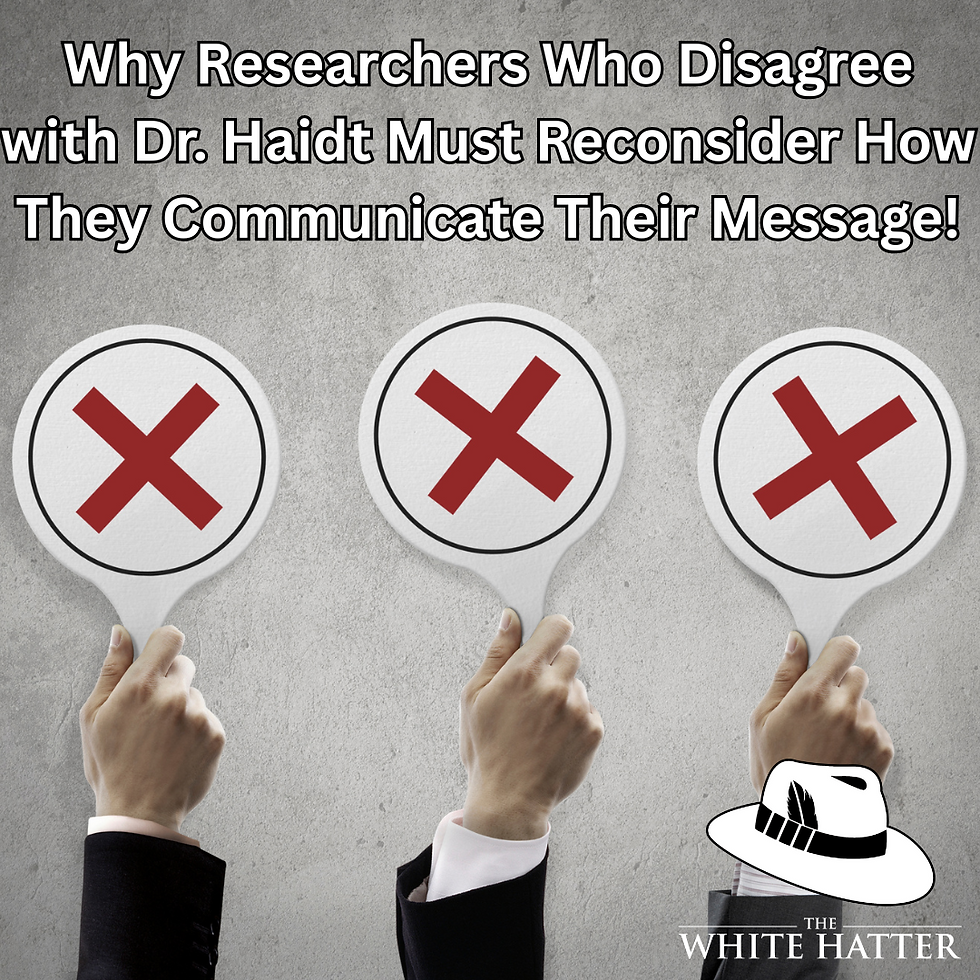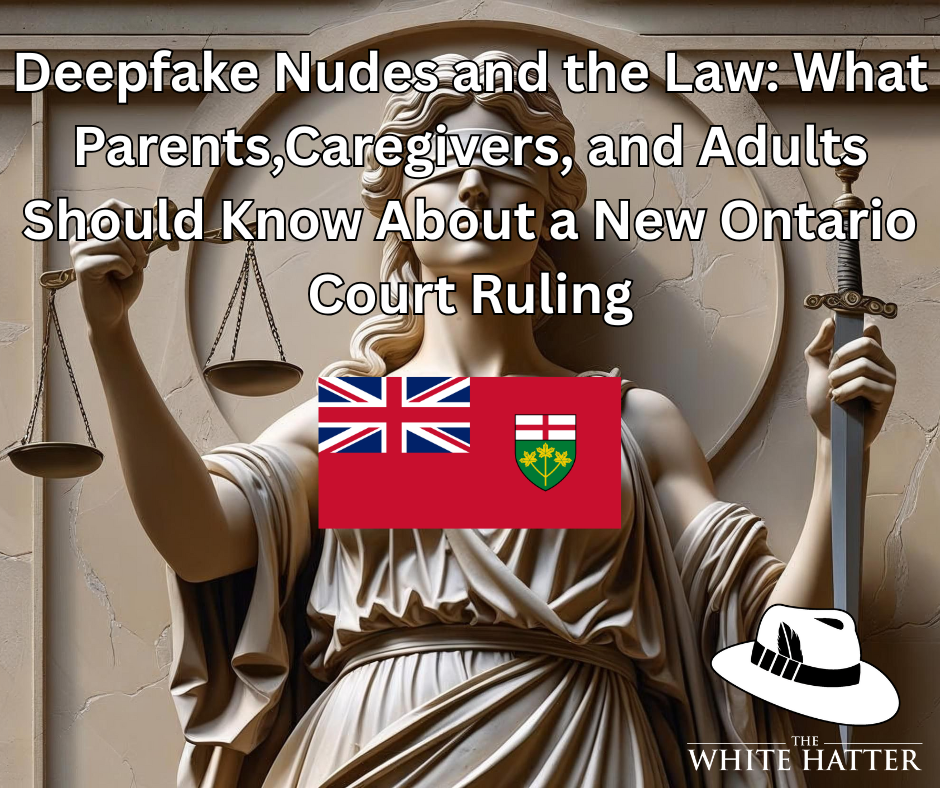Why Researchers Who Disagree with Dr. Haidt Must Reconsider How They Communicate Their Message!
- The White Hatter

- Sep 21
- 4 min read

Caveat - We wrote this article drawing on our experience in communicating with hundreds of thousands of youth, teens, parents, caregivers, and other adults in today’s hyper-connected world, on the topics of digital literacy and internet safety, security, and privacy.
First, let’s give credit, where credit is due! Dr. Jonathan Haidt has captured the attention of parents, educators, policymakers, and the public with his arguments about youth, technology, and mental health. Whether one agrees with him or not, it’s clear that his message resonates. He has done what many in the scientific community struggle to do, and that is to translate complex research into his own narrative that feels urgent, relatable, easy to share, and connects with parents, caregivers, and policy makers.
When we speak with parents, caregivers, and educators, many reference Dr. Haidt’s book, “The Anxious Generation.” Yet when we ask if they’ve read Dr. Pete Etchells’ book, “Unlocked: The Real Science of Screen Time (and How to Spend It Better)”, or Catherine Knibb’s book, “Tech Smart Parenting: How to Keep Your Kids Happy & Safe Online”, most look at us blankly, unaware these books even exist. What continues to strike us is that when we recommend these books and parents take the time to read them, they often come back to us describing a sense of enlightenment. They’re surprised to learn what the evidence-based, peer-reviewed research actually shows, and how it often contradicts the claims Dr. Haidt makes in his book.
For those in the scientific community who disagree with Dr. Haidt, the challenge isn’t just about presenting different data. It’s about recognizing that the way science and research is communicated has fundamentally changed, and something we believe Dr. Haidt has leveraged. Prestige, credentials, and academic rigour alone are no longer enough to sway public opinion.
In the past, experts could rely on peer reviewed journals, legacy media gatekeepers, and institutional authority to filter and amplify their message. Today’s reality is different. Influence spreads through networks, not academic hierarchies. Audiences decide what to share, algorithms amplify what resonates, and creators with no traditional credentials often shape the narrative.
Dr. Haidt has embraced this shift. He writes books that connect emotionally, appears on podcasts and YouTube channels where everyday people listen, and frames his message in ways that spark conversations across dinner tables and classrooms. Dr Haidt’s target audience isn’t fellow academics, but rather mom’s and dad’s. Like it or not, Dr Haidt has captured the human algorithm of emotion. This is why his ideas, whether fully supported by data or not, dominate public discourse.
If researchers want to push back effectively, it is our humble opinion they cannot rely on publishing a rebuttal in an academic journal and expect it to travel far. They need to engage the same ecosystem that Dr. Haidt and his followers have mastered.
Researchers need to recognize that emotional resonance matters. Facts are necessary, but they are rarely enough on their own. What moves people are stories that feel personal, examples that stick, and explanations that connect research findings to everyday life. When experts speak in purely abstract or statistical/scientific terms, their message gets lost to the average parent or caregiver. When they tie those findings to the lived experience of parents, educators, and teens, the message has a chance to land.
Accessibility is another key element. Too often, important research remains locked behind paywalls or is communicated in language so dense in scientific language that it alienates the very people who need to hear it. Academic researchers who want to be heard outside their own circles of academics, must translate their work into clear, plain language. This doesn’t mean watering down the science, it means stripping away unnecessary jargon so that ideas can travel beyond academic borders. The public craves clarity, not complexity for its own sake.
Responsiveness also plays a role in building trust. Communication can’t be treated as a one way transmission that ends with the publication of a paper or the release of a statement. The public wants to see experts who engage, answer questions, and participate in the ongoing conversation. When researchers respond thoughtfully to concerns and criticisms, they demonstrate credibility and approachability in ways that static reports never could.
Researchers must become fluent in the communities where conversations are actually happening. This means finding the time to step into podcasts, social media platforms, parent forums, and even school events, rather than waiting for the public to come to traditional academic spaces. Meeting people where they are is no longer optional, it is the cost of entry for having influence in today’s information environment.
If academic voices countering Dr Haidt’s message fail to adapt, their research risks irrelevance outside academia. The danger is not just that one person’s perspective dominates the conversation, but that public discourse becomes less evidence informed overall. By learning from Dr. Haidt’s success, not in adopting his conclusions, but in adopting his communication strategies, other researchers can ensure that parents and the public hear a broader, more balanced set of perspectives.
The scientific and research community doesn’t need to compromise its rigour. It needs to reframe how it connects. Communication can no longer be treated as an afterthought once research is complete. It must be woven into the work from the start. Building trust, cultivating relationships, and embracing new messengers and formats are not “extras”, they are essential if fact based perspectives are to matter in today’s networked world!
Dr. Haidt has already proven that compelling communication shapes the public narrative. Those who disagree with him need to stop relying on the old rules of influence, and start participating in the new ones outside the academic echo chamber.
Digital Food For Thought
The White Hatter
Facts Not Fear, Facts Not Emotions, Enlighten Not Frighten, Know Tech Not No Tech














